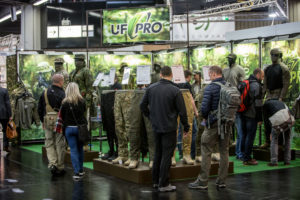ESD asked Armin Wagner, Co-owner & Chief of Product Development, UF PRO, on the newest developments in the tactical market.
ESD: What are the key performance features that separate the new Striker X Combat Pants from other products on the market?
Wagner: The Striker X Combat Pants were developed with military operators in mind. We have taken their feedback and needs as the base idea behind the design of this model.
The key aspects that separate these from non-UF PRO options are top-notch ergonomic fit, a focus on sturdiness and field repairability of vital parts, “no-melt/no-drip” materials used and plentiful the functional elements that work very well for you in the field.
ESD: And what is new compared with your other trousers?
Wagner: A lot. The changes to our newest model of the Striker lineup are the incarnations of the feedback and needs of military personnel.
Therefore, the Striker X are a totally different concept.
The first major change is the overall construction of the pants. We reduced the amounts of so called “critical seams.” What this means is that the seams are overlapping with other parts of the fabric and are more of “part of the garment” than sewn onto a base model of the pants.
What this does is it makes the final product extremely rugged and robust and much more durable, when it comes to tearing or breaking.
The pants are also “no-melt/no-drip.”
The second difference is the modified knee protection system with the width regulation on the backside. This allows the operators to adjust the fit to their knee shape, easily and ensure the fit is optimal for them.
At third place we have the ease of repairability in the field. The new Striker X feature elements like velcro straps or Canadian buttons in places where our other models have zippers installed, allowing operators to repair them on the field more easily.
While our zippers used in our garments are extremely resilient and not prone to any kind of damage, we reduced the amount by a few and used the closure systems requested by the military-branch.
The last thing is the changes to the pocket systems we are using.
The side pockets now feature a flap closure system, with Canadian buttons or alternatively velcro straps – they come with the pants and you can easily install those. To double down, they have an elastic cord, to secure your gear, if the buttons fail you and break off. On the inside of the pocket you can notice there are elastic straps to keep your gear in place and they are much more spacious, allowing you to store more gear.
There are two new flap covered pockets on the front, an addition to the already present small knife/magazine pocket. Lower leg pocket has received an update as well, the zipper is now vertical, for easier access when you are kneeling and we have added elastic straps for securing any gear you have in there.
ESD: What material are the combat pants made of?
Wagner: The base face fabric is made out of 50% Nylon and 50% Cotton Ripstop (which is mostly known as NyCo ripstop). This is the classic US MILSPEC fabric, which is widely used all around the globe by military forces.
The Striker X model uses Schoeller-Dynamic (92% polyamide, 8% Elasthan) stretch panels, a durable and elastic material on the back side and below the knee section.
The third material in use is 100% CORDURA fabric (500 denier), which we incorporate to reinforce the most crucial parts of the pants and prevent the damage caused by abrasion, like the instep, belt loops and the knee area.
For the German Flecktarn version, which will come out next year, the basic material is a Polycotton blend, which is required by the German military specification.
ESD: For what temperature range has the Striker X been optimized?
Wagner: Giving the exact temperature range for any garment is quite a complex task to tackle.
It is very dependent on external factors like humidity, air pressure, outside temperature and on your body as well. Here we mainly mean the operator’s activity level, the higher it is, the more the breathability of the garment is put to the test.
Our personal experience with the pants ranges from above 35°C to below -10°C. On the colder end, we suggest to combine with the proper underwear, and/or the WINDSTOPPER Liner.
 ESD: You also present some new camouflage patterns, why was it necessary to invent new patterns?
ESD: You also present some new camouflage patterns, why was it necessary to invent new patterns?
Wagner: For the Striker X Combat Pants, we are not planning on using any new camouflage patterns. We only manufacture the garments and do not develop our own patterns.
The Striker X are for now, going to be available in MultiCam and Brown Grey – in the U.S. this would be Ranger Green.
On a side note; we did however launch a new camouflage pattern for our gear in the new German camouflage CONCAMO. Based on the feedback from our customers, this is an excellent addition to our already broad range of colours and patterns and we are looking forward to bringing it to the next generations of our products.
ESD: How do you test if the camouflage is more successful than other patterns?
Wagner: We might have an opinion about camouflage properties of the different camouflage patterns, but use the camouflage patterns, which are requested by our end users.
If it works for them in the field and the operators have a clear-cut opinion about its effectiveness, we are going to look into it and usually bring it as a new variant to our existing models.
The questions were asked by Dorothee Frank.
For more information please visit the company’s page: https://ufpro.com/
Or see the new products at UF PRO’s booth at MILIPOL: 5D 083



